The ASUS Zenbook UX305 Review
by Brett Howse on March 25, 2015 8:00 AM ESTSystem Performance
ASUS has employed the Intel Core M processor in the design of the UX305, and unlike the first device we tested with Core M, ASUS has created the UX305 as a fanless design. This is likely easier to achieve when you consider that the UX305 is completely constructed out of aluminum. Aluminum is a great conductor of heat, and allows a big part of the laptop to be a cooling surface. The heat is also kept at the top of the keyboard deck, where it is less likely to be noticed when using the laptop. During most general use of the UX305, it does not get warm anyway, and only when used for extended periods of high use did I notice it get hot.
The UX305 will be offered with either the Core M-5Y10 or 5Y71 processors, although for North America the 5Y10 is the only available processor right now. It is a dual-core, quad-thread CPU with an 800 MHz base frequency, and 2 GHz boost frequency. This is a big step down from the 5Y71 which has a 1.2 GHz base and 2.9 GHz boost capability, so it will be interesting to see how the UX305 performs. I have highlighted the Lenovo Yoga 3 Pro since it is the only other Core M device we have tested, and it has the Core M-5Y71 processor onboard.
To compare the performance, I have selected a sampling of devices that we have tested which are roughly the same class of device. To compare the UX305 to any other device we have tested, please use our Notebook Bench.
PCMark
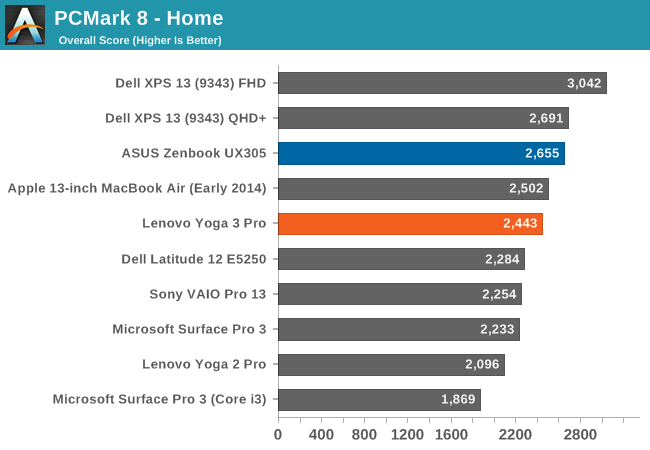
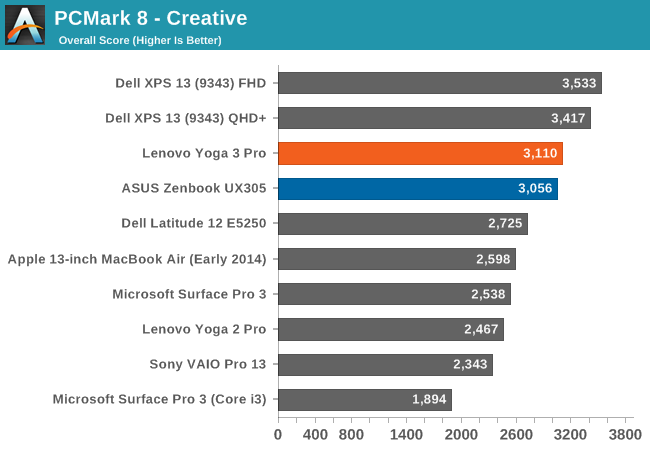
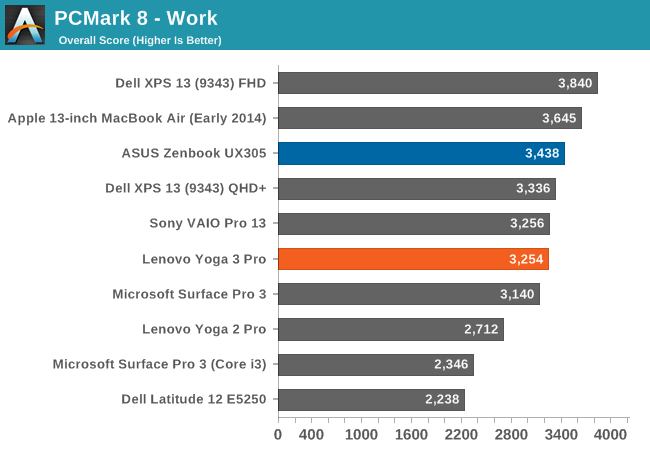
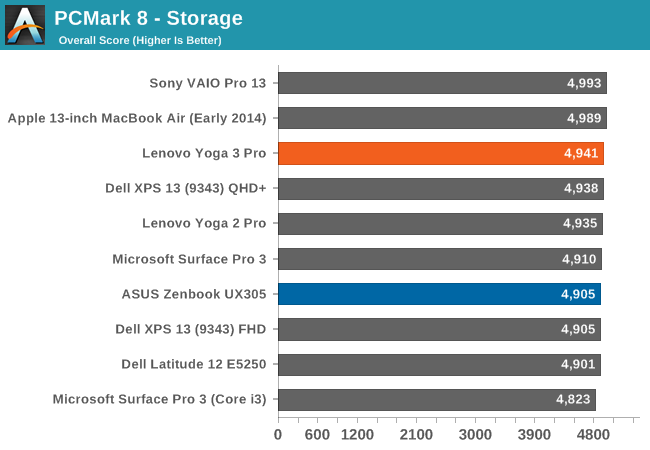
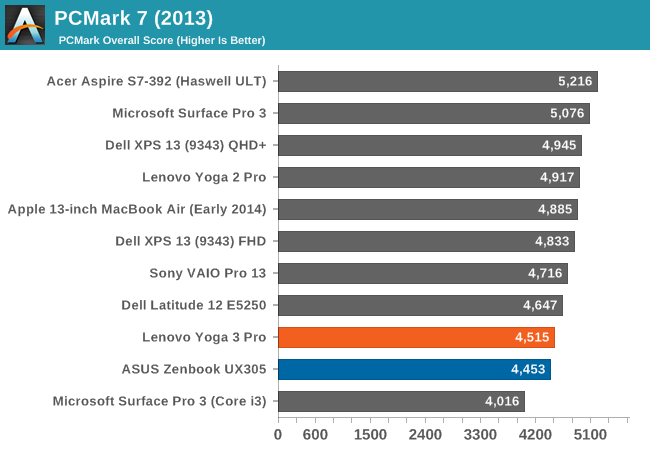
PCMark 8 performs four sets of tests, with different use case scenarios to get a feel for how the device will perform on several different sets of tasks. The UX305 performs quite well here, despite the Core M processor. You can see that it even outperforms the Yoga 3 Pro on several of the tests, and it has a faster version of the Core M CPU. We will dig into that more in a bit.
Cinebench and x264
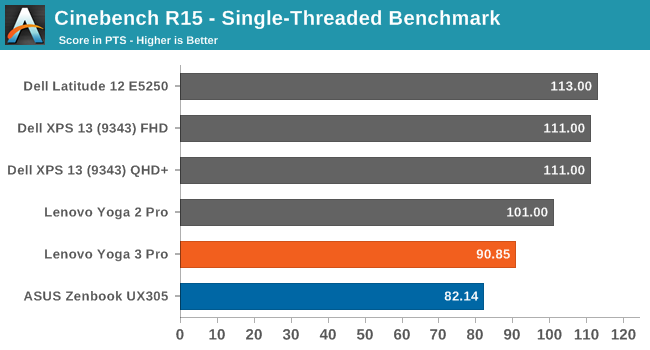
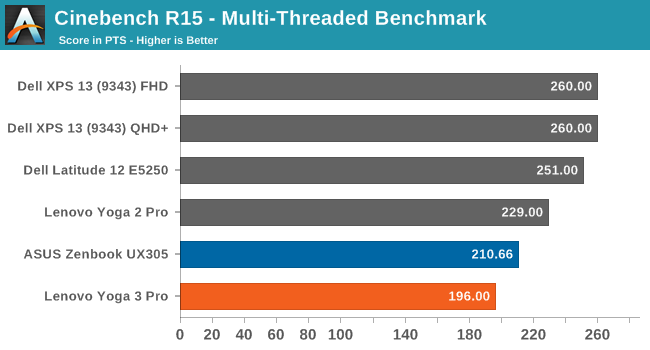

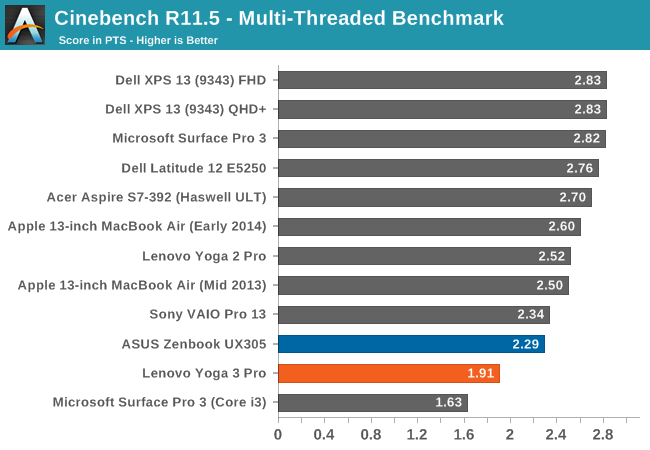
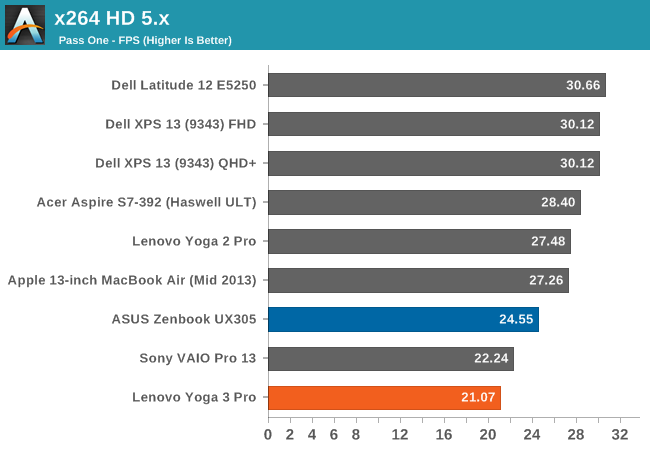
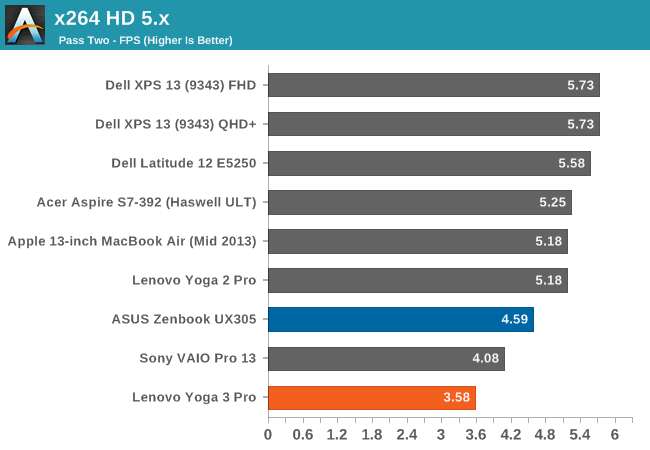
On the single-threaded runs of Cinebench, The UX305 is near the bottom of the pack. That is unsurprising, since it has a boost clock of just 2 GHz, and furthermore on a single-threaded runs most CPUs can usually perform very close to their boost clock for the duration. Consequently the extra 900 MHz on the Yoga 3 Pro's 5Y71 pulls a big lead here. It is interesting to note that the only Haswell-Y based processor that was in Bench was the Core i3 version of the Surface Pro 3. Broadwell-Y (Core M) handily outperforms it in both single and multi-threaded workloads. This has a lot to do with the Core i3 having no boost clocks at all.
Moving on to the Multi-threaded workloads, we can see that the UX305 is still near the bottom of the chart, but it has passed the Yoga 3 Pro with 5Y71. The same thing occurs on the x264 benchmark, which lasts several hours. We need to see a couple of more benchmarks to get an idea of what is going on.
TouchXPRT 2014
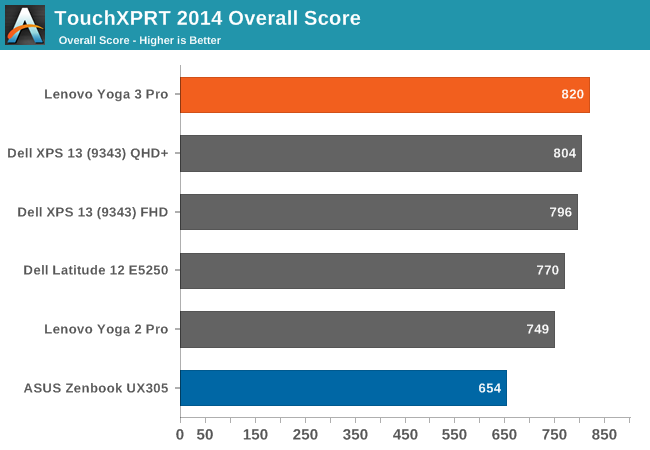

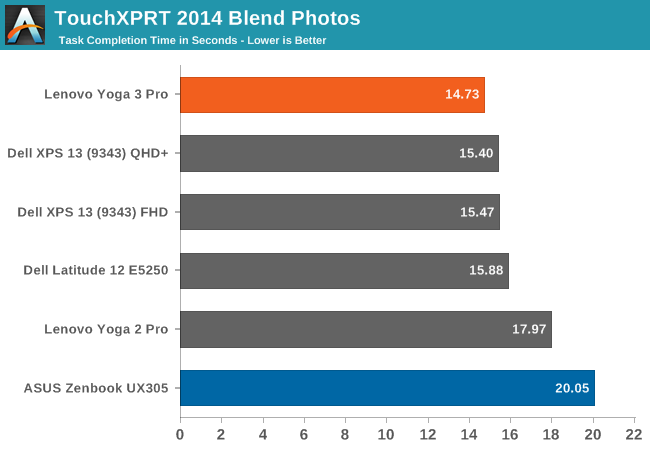
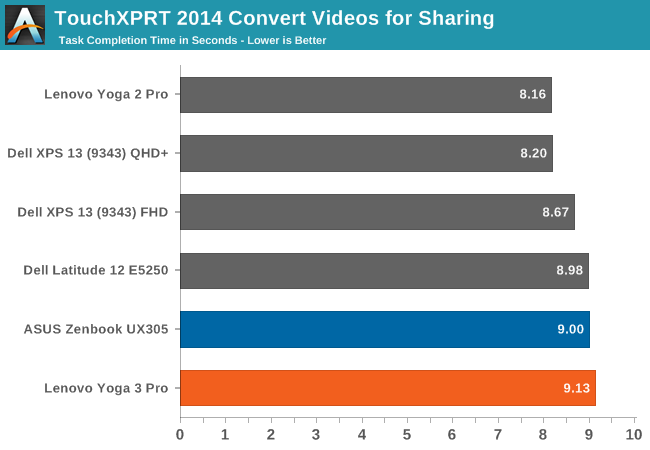
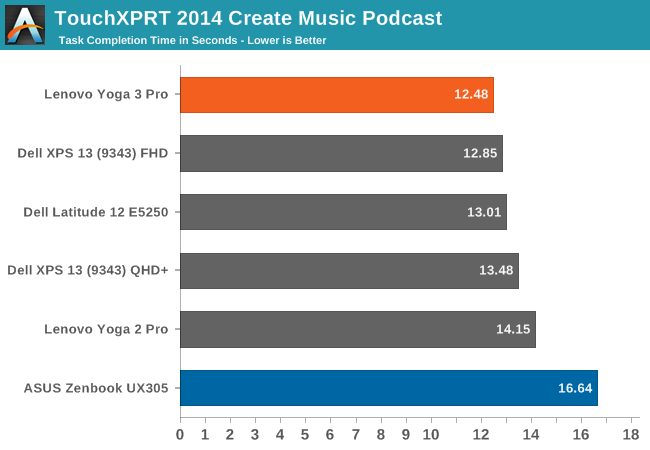
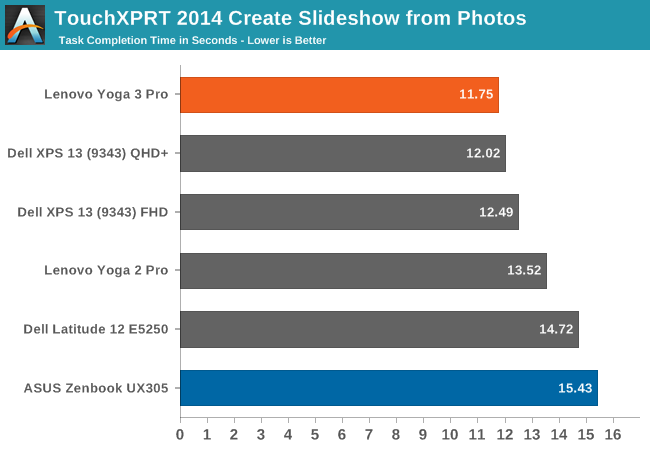
TouchXPRT is a Windows Store benchmark which performs several common tasks that someone at home may perform. All of the benchmarks result in a time to complete a task, which is then converted into an overall score. Here the UX305 plummets to the bottom of the charts, owing once again to its relatively low boost clock, scoring the lowest overall score of any device we have tested. The Yoga 3 Pro on the other hand with Core M 5Y71 and a 2.9 GHz boost clock has the highest overall score of any of the Ultrabooks in the chart. Once again we see a very different result from the previous test.
Web Benchmarks
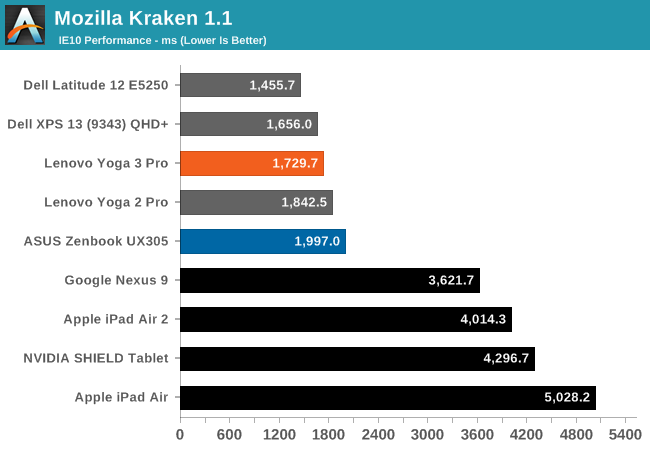

Running Javascript based browser benchmarks, the UX305 with Core M 5Y10 once again falls to the bottom of the chart. With just a 2 GHz boost clock, the 5Y10 struggles to compete against the likes of other laptops with faster Core M or U series processors. The ASUS UX305 cannot be converted into a tablet, but I have included some tablet benchmarks here just to show how Core M-5Y10 compares against the best performing tablets. With around the same power envelope, even the slowest Core M is still significantly faster than any tablet in CPU performance.
Explaining Core M Performance
On system performance, we have seen some fairly wild swings when comparing the UX305 with the slowest Core M processor available to other devices, especially the Yoga 3 Pro which has the fastest Core M released so far with the 5Y71. The Yoga 3 Pro even includes a fan, whereas the UX305 is passively cooled. On quick, burst benchmarks such as TouchXPRT, and on single-threaded benchmarks such as Cinebench, and even on the web tests the Yoga 3 Pro with 5Y71 offers a lot more performance. However on the longer benchmarks the UX305 pulls ahead despite the lower base and boost clock speeds.
Traditionally, it was just a given that higher numbered processors of the same processor family would give you better performance, but with the kind of devices Core M is being integrated into, that is not the case at all. There are a lot more factors at play when you look at Core M as a whole in order to understand where the performance level is going to be. For example, ASUS has opted to allow the processor to get much hotter, which then translates to higher surface temperatures on the device, especially since it is passively cooled. But this lets Core M keep its clock speeds higher when performing extended workloads. Lenovo on the other hand, even with a fan, has opted to keep the CPU temperature much lower, but that forces the CPU to throttle down under extended workloads. On a long test, the ASUS CPU hit as high as 80°C, but the Lenovo kept the CPU to around 60°C, and due to the fan, the surface temps of the laptop did not get warm very much at all.
The performance of Core M is much more akin to how a smartphone or tablet is limited in performance, where the manufacturer has to look at overall device temperatures and decide where they want to limit performance. ASUS has chosen a much more aggressive temperature, and it does not affect the device use very much because it is a laptop, and therefore can be used on a desk. You do not have to hold the device, so even though it can get to over 47°C (117°F) between the display and the top of the keyboard, the palm rests and keyboard never get warm at all. The aluminum chassis comes into play and can act as a large heat sink. Lenovo has chosen a much lower device temperature, but the Yoga 3 Pro is a convertible and can be used as a tablet, so having such a high surface temperature would be a big issue. Of course, if you are using the UX305 in your lap, it would be very uncomfortable as well, so watch out for that. For general tasks, the device does not get warm, but if you are doing extended heavy workloads, it can be an issue.
One such task which causes heavy use for extended times is gaming, so next up is GPU performance.










164 Comments
View All Comments
Klug4Pres - Wednesday, March 25, 2015 - link
I don't know why people want to buy these thin & light machines. What is wrong with a 5 lb laptop with a 35 Watt CPU, four RAM slots, two spindles, 14.1 inch 4:3 SXGA+ screen etc.? I keep being told "the ship has sailed", but I have no idea why.Novacius - Wednesday, March 25, 2015 - link
If you're traveling a lot or just have to take your laptop with you every day, you appreciate a lighter laptop. Very, very much. They also have much better battery life.Ian Cutress - Wednesday, March 25, 2015 - link
I used to carry a 4kg laptop with extended battery, 1200p screen etc to events like Computex and day trips/meetings for a couple of years. Put it this way, I'm glad I have a UX301 now at just over 2lbs. That being said, there are a few lighter weight systems that have me interested, like the LaVie Z that we saw at CES.Refuge - Wednesday, March 25, 2015 - link
I am the definition of a desktop replacement buyer.But even I see the relief in pulling out a 2lb feather on an airplane rather than some 17in 7lb beast.
Although those days are even coming to an end. Now you want a desktop replacement, the new Gigabyte P35X is a perfect idea! Thin, light, and TONS of horsepower. :)
Flunk - Wednesday, March 25, 2015 - link
If you want light and power I'd recommend getting a desktop AND a thin and light notebook. Why? The compromises necessary for thin and light notebooks are not compatible with the idea of a powerful notebook. Because of this you have to make a lot of compromises when it comes to heat, battery life, performance, price. At some point it might be possible but you can't get the best of both worlds right now.killeak - Wednesday, March 25, 2015 - link
Well, I disagree. As a render programmer that travels and works remote a lot (once every two months as minimum) I need a powerful laptop to work with. And the true is that these days there is plenty of great options that give you both (portability and performance). Recently I bought a Clevo p650sg (i7 4720hq, 980m, 32gb RAM, 2xSSD 500 + HD 1tb) for 2k usd. That being said, I do have a modern desktop PC at home that I bought last year (i7 4790, 16gb RAM, 500gb SSD + 2tb storage and a GeForce 770), but I prefer to use my laptop (I also bring it to the office and I plug to monitors and keyboard to increase my productivity). Performance wise, I will say that there is not much difference between my new laptop and the desktop that I use, in fact my new laptop is more powerful than my desktop at work except for the CPU (4770, 16gb RAM, 256 SSD and geforce 760).I love to have the performance of a powerful desktop in 2.6kg (before I had a Lenovo Y500, not that powerful but close and same weight). These days I use my desktop pc at home more as a media server and some occasional gaming on the TV than for work or main gaming platform (in any case I play SC2 and Civ5 mostly and I can play those on my laptop, even my old one).
That being said, I do see the point of ultrabook or hybrids. I also have an Asus T100 that I use as my true mobile laptop/tablet that I bring with me everywhere. For web surfing, mails, word/excel, watching movies/series at the airport/airplane, etc. is great, and battery life is awesome. I see myself buying a Surface Pro 4 or something like it in the future, to replace the T100, but not for actual work since I need a true i7 (not ULV), lot of ram and a powerful GPU, that I can bring with me when I travel.
Refuge - Wednesday, March 25, 2015 - link
I disagree, but only half.While you are correct and if you want power then there is no better solution than a full fledged desktop.
But you can't say that Laptops can't be defined as powerful when it is toting a 4ghz I7 with a GTX 980m. That is like saying a Corvette isn't sports car because it isn't a Ferrari. Laughable I know right?
Either way, broad stroke generalizations like that are quickly falling apart with each passing year as they cram more and more power into smaller and smaller packages. Anymore you are really only lacking in personal upradability. Which I can see being a big enough problem to turn people towards a desktop form factor of some sort.
andrewaggb - Wednesday, March 25, 2015 - link
I mostly agree, I've done the 17" laptop with dedicated graphics. It quickly lost it's ability to play the latest games with high settings, and eventually do play the latest with reasonable settings. It's battery life sucks, it's heavy, it's useless on an airplane, etc.It was handy for gaming on vacation though. I've been tempted to buy 2 new laptop's, another gaming/big screen 17" laptop and a 12 or 13" ultralight. They're both laptops, but they serve completely different purposes.
Conficio - Wednesday, March 25, 2015 - link
Working with two machines brings a lot of hassles of its own. Installing apps twice, upgrading twice, synching data, etc. having more storage on the desktop means you have to be selective and then you go the wrong selection on the road.I'd wish I could have an OS that has a seamless cloud extended storage, synching apps and documents a I need. Did I describe ChromeOS here?
kingpotnoodle - Wednesday, March 25, 2015 - link
Because (very obviously) if you don't need a powerful machine but you do a lot of travelling then it's much better to have a lighter machine with a long battery life. Most of my work is web/ssh/rdp, long battery life and lighter weight are FAR more important to me than it being able to play Crysis or do video editing lightning fast.